An Investigation on the Effects of Input Parameters on the Dynamic and Electric Consumption of Electric Motorcycles
Abstract
:1. Introduction
2. Simulation Study
2.1. Simulation Study of Electric Motorcycle
2.2. Electric Motorcycle Performance
2.3. Battery Models
3. Results and Discussion
3.1. Model Validation
3.2. Effect of Electric Motorcycle Mass
3.3. Effect of Driver Mass
3.4. Effect of Wheel Radius
3.5. Effect of Frontal Area
3.6. Effect of Transmission Ratio
4. Conclusions
- When the electric motorcycle mass was increased from 60 kg to 100 kg, the maximum velocity decreased from 73.73 km/h to 69.71 km/h (5.45%), the moving distance was reduced from 743.68 m to 699.82 m (5.89%), and electricity consumption increased by 0.11%, respectively;
- Following an increased driver mass from 48 kg to 88 kg, the velocity and moving distance decreased from 73.73 km/h to 69.71 km/h (5.45%) and from 743.68 m to 699.82 m (5.89%), respectively, while electricity consumption increased by 0.11%;
- When the wheel radius was changed from 0.205 m to 0.245m, the maximum velocity increased from 68.62 km/h to 76.2 km/h (11%), the moving distance increased from 689.47 m to 766.75 m (11.2%), and electricity consumption increased by 0.11%;
- When the frontal area was increased from 0.52 m2 to 0.92 m2, the velocity and moving distance decreased from 72.01 km/h to 70.3 km/h (2.43%), and from 721.47 m to 706.9 (2.06%), respectively, electricity consumption increased;
- When the transmission ratio was increased from 2.66 to 4.94, the velocity and moving distance increased from 30.74 km/h to 70.7 km/h, and from 303.12 m to 710.44 m, respectively, the electric consumption increased by 0.16%.
Author Contributions
Funding
Data Availability Statement
Conflicts of Interest
Nomenclature
| M | Total mass including driver and electric motorcycle mass (kg) |
| Cs | Slope resistance coefficient (Cs = sin(α)), |
| Afa | Frontal area (m2) |
| Ca | Aerodynamic drag coefficient |
| Air density, kg/m3 | |
| vw | Velocity of wind, km/h |
| vEM | Electric motorcycle velocity, km/h |
| g | Gravitational of Earth, m/s2 |
| Crr | Rolling resistance coefficient |
| x | Moving distance (m) |
| a | The acceleration (m/s2) |
| Rw | Wheel radius (m) |
| Transmission ratio | |
| Tm | The motor torque (N.m) |
| La | The motor inductance (H) |
| I | The motor current (A) |
| t | The time (s) |
| Ra | The motor electrical resistance |
| Kb | The back-emf constant |
| wm | The motor shaft angular velocity |
| Ka | The amplification coefficient of motor |
| u | The input voltage |
| J | The inertia moment of motor (N.m) |
| B1 | The friction coefficient of motor |
| Vb | The battery voltage (V) |
| E0 | The battery constant voltage (V) |
| K | The polarization constant (V/Ah) |
| Q | The battery capacity (Ah) |
| R | The internal resistance |
| A | The exponential zone amplitude (V) |
| Ec | The back EMF |
| Te | The produced torque |
References
- Khoa, N.X.; Nhu, Y.Q.; Lim, O. Estimation of parameters affected in internal exhaust residual gases recirculation and the influence of exhaust residual gas on performance and emission of a spark ignition engine. Appl. Energy 2020, 278, 115699. [Google Scholar] [CrossRef]
- Khoa, N.X.; Lim, O. The effects of combustion duration on residual gas, effective release energy, engine power and engine emissions characteristics of the motorcycle engine. Appl. Energy 2019, 248, 54–63. [Google Scholar] [CrossRef]
- Szwaja, S.; Ansari, E.; Rao, S.; Szwaja, M.; Grab-Rogalinski, K.; Naber, J.D.; Pyrc, M. Influence of exhaust residuals on combustion phases, exhaust toxic emission and fuel consumption from a natural gas fueled spark-ignition engine. Energy Convers. Manag. 2018, 165, 440–446. [Google Scholar] [CrossRef]
- Bhandarkar, S. Vehicular Pollution, Their Effect on Human Heatlh and Mitigation Measures. Veh. Eng. 2013, 1, 33–40. [Google Scholar]
- Coronado, C.R.; de Carvalho, J.A., Jr.; Yoshioka, J.T.; Silveira, J.L. Determination of ecological efficiency in internal combustion engines: The use of biodiesel. Appl. Therm. Eng. 2009, 29, 1887–1892. [Google Scholar] [CrossRef]
- Dou, X.; Linn, J. How do US passenger vehicle fuel economy standards affect new vehicle purchases? J. Environ. Econ. Manag. 2020, 102, 102332. [Google Scholar] [CrossRef]
- Xing, H.; Stuart, C.; Spence, S.; Chen, H. Alternative fuel options for low carbon maritime transportation: Pathways to 2050. J. Clean. Prod. 2021, 297, 126651. [Google Scholar] [CrossRef]
- Prussi, M.; Scarlat, N.; Acciaro, M.; Kosmas, V. Potential and limiting factors in the use of alternative fuels in the European maritime sector. J. Clean. Prod. 2021, 291, 125849. [Google Scholar] [CrossRef]
- Ibrahim, A.; Jiang, F. The electric vehicle energy management: An overview of the energy system and related modeling and simulation. Renew. Sustain. Energy Rev. 2021, 144, 111049. [Google Scholar] [CrossRef]
- Lin, J.; Zhou, W.; Wolfson, O. Electric vehicle routing problem, Transportation research procedia 2016. In Proceedings of the 9th International Conference on City Logistics, Tenerife, Spain, 17–19 June 2015. [Google Scholar]
- Hung, N.B.; Lim, O. A review of history, development, design and research of electric bicycles. Appl. Energy 2020, 260, 114323. [Google Scholar] [CrossRef]
- Liu, Y.; Lai, I.K.W. The Effects of Environmental Policy and the Perception of Electric Motorcycles on the Acceptance of Electric Motorcycles: An Empirical Study in Macau. SAGE Open 2020, 10, 1–14. [Google Scholar] [CrossRef]
- Propfe, B.; Redelbach, M.; Santini, D.J.; Friedrich, H. Cost analysis of Plug-in Hybrid Electric Vehicles including Maintenance & Repair Costs and Resale Values. World Electr. Veh. J. 2012, 5, 886–895. [Google Scholar] [CrossRef] [Green Version]
- Noori, M.; Tatari, O. Development of an agent-based model for regional market penetration projections of electric vehicles in the United States. Energy 2016, 96, 215–230. [Google Scholar] [CrossRef]
- Riesz, J.; Sotiriadis, C. Daisy Ambach, Stuart Donovan. uantifying the costs of a rapid transition to electric vehicles. Appl. Energy 2016, 180, 287–300. [Google Scholar] [CrossRef]
- Gass, V.; Schmidt, J.; Schmid, E. Analysis of alternative policy instruments to promote electric vehicles in Austria. Renew. Energy 2014, 61, 96–101. [Google Scholar] [CrossRef]
- Wu, J.-H.; Wu, C.-W.; Lee, C.-T.; Lee, H.-J. Green purchase intentions: An exploratory study of the Taiwanese electric motorcycle market. J. Bus. Res. 2015, 68, 829–833. [Google Scholar] [CrossRef]
- Asaei, B.; Habibidoost, M. Design, simulation, and prototype production of a through the road parallel hybrid electric motorcycle. Energy Convers. Manag. 2013, 71, 12–20. [Google Scholar] [CrossRef]
- Weigl, J.D.; Henz, M.; Saidi, H. Converted battery-powered electric motorcycle and hydrogen fuel cell-powered electric motorcycle in South East Asia: Development and performance test. In Proceedings of the Joint International Conference on Electric Vehicular Technology and Industrial, Mechanical, Electrical and Chemical Engineering (ICEVT & IMECE), Surakarta, Indonesia, 4–5 November 2015; Institute of Electrical and Electronics Engineers (IEEE): Manhattan, NY, USA; pp. 1–4. [Google Scholar]
- Abu Hanifah, R.; Toha, S.F.; Hanif, N.H.H.M.; Kamisan, N.A. Electric Motorcycle Modeling for Speed Tracking and Range Travelled Estimation. IEEE Access 2019, 7, 26821–26829. [Google Scholar] [CrossRef]
- Farzaneh, A.; Farjah, E.; Farzaneh, A. A Novel Smart Energy Management System in Pure Electric Motorcycle Using COA. IEEE Trans. Intell. Veh. 2019, 4, 600–608. [Google Scholar] [CrossRef]
- Farzaneh, A.; Farjah, E. Analysis of Road Curvature’s Effects on Electric Motorcycle Energy Consumption. Energy 2018, 151, 160–166. [Google Scholar] [CrossRef]
- Yildiz, A.B. Electrical equivalent circuit based modeling and analysis of direct current motors. Int. J. Electr. Power Energy Syst. 2012, 43, 1043–1047. [Google Scholar] [CrossRef]
- Abagnale, C.; Cardone, M.; Iodice, P.; Strano, S.; Terzo, M.; Vorraro, G. Derivation and Validation of a Mathematical Model for a Novel Electric Bicycle. In Proceedings of the World Congress on Engineering, London, UK, 1–3 July 2015. [Google Scholar]
- Tremblay, O.; Dessaint, L.-A. Experimental Validation of a Battery Dynamic Model for EV Applications. World Electr. Veh. J. 2009, 3, 289–298. [Google Scholar] [CrossRef] [Green Version]
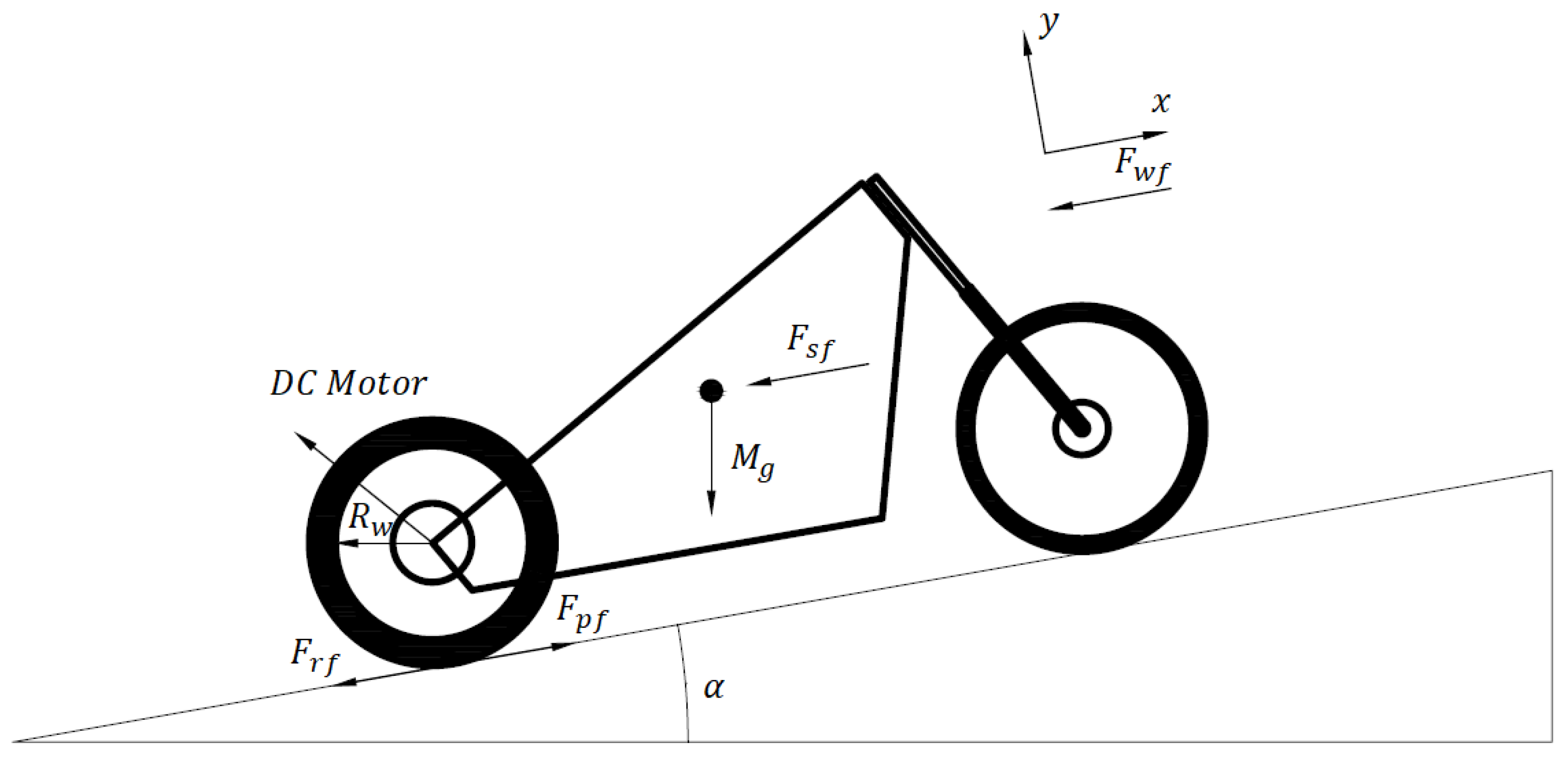


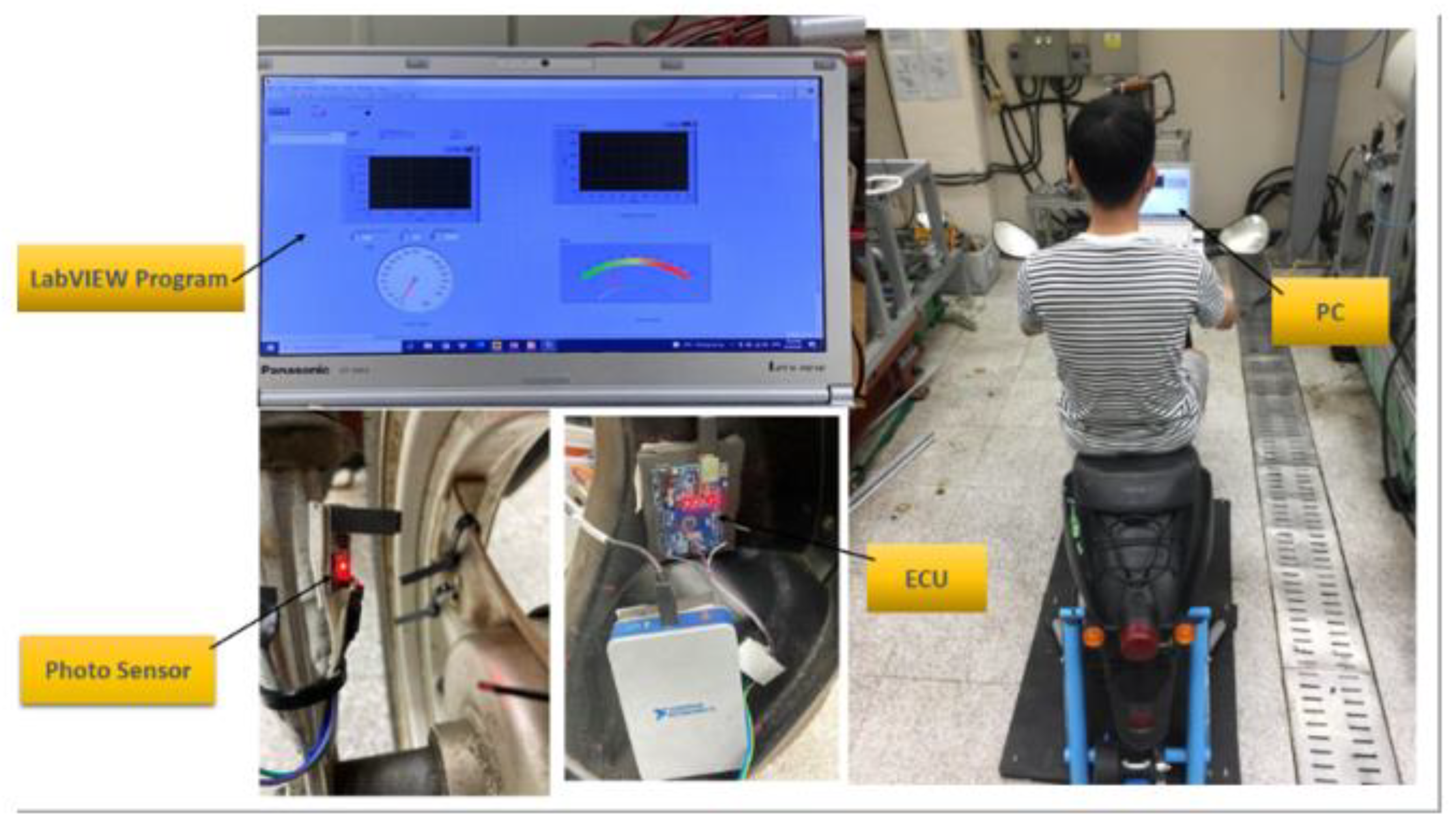

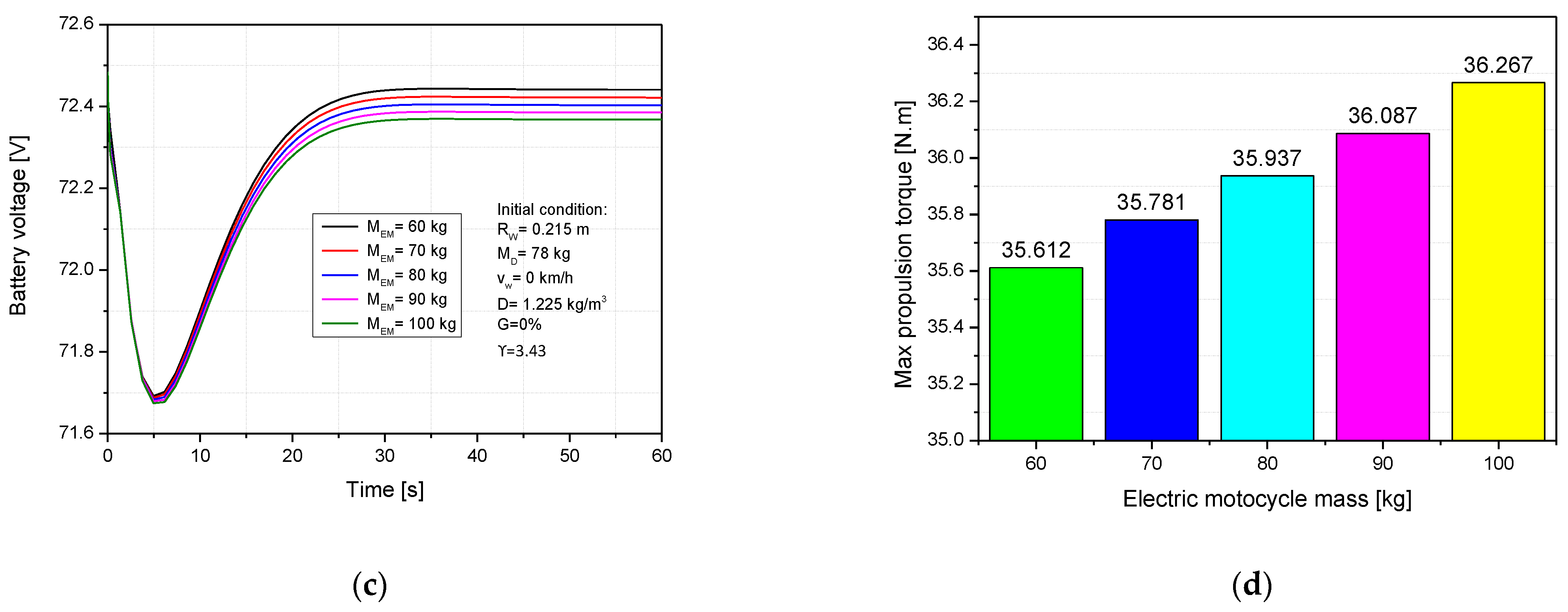
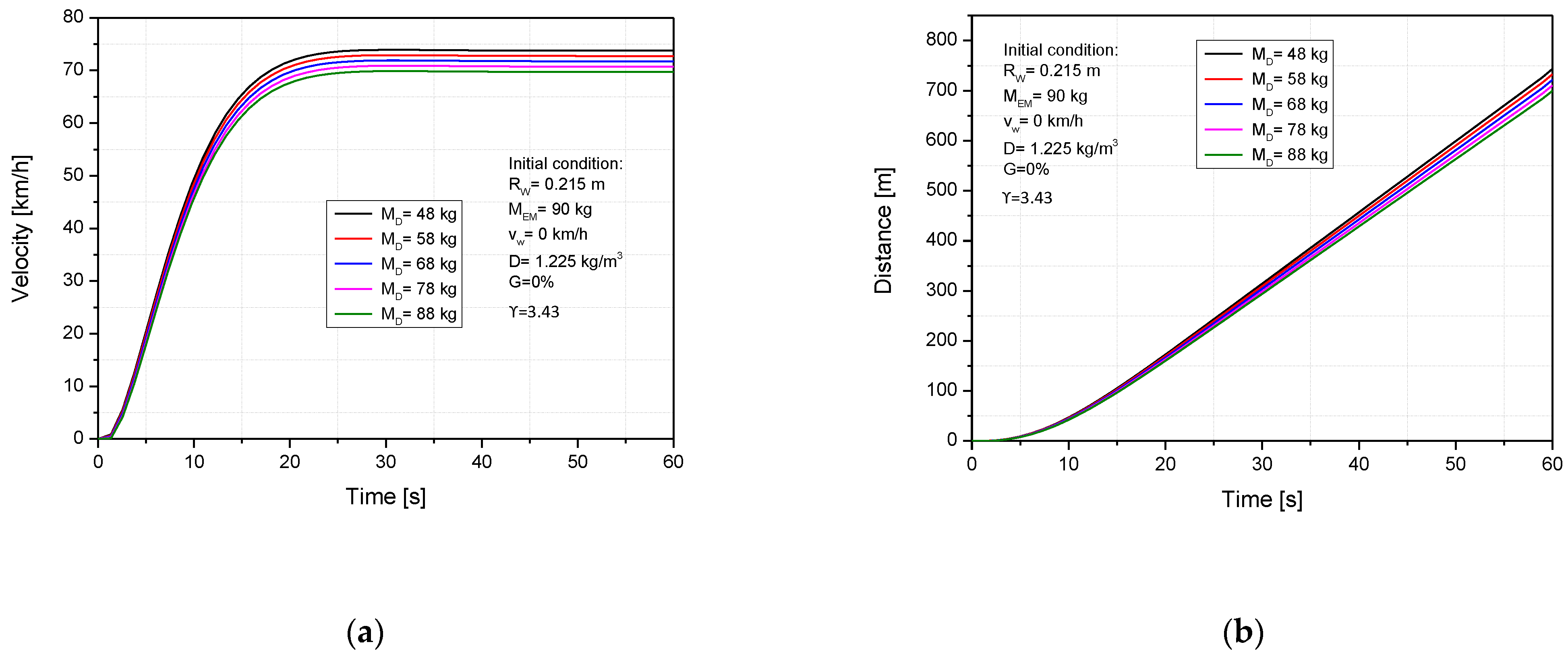
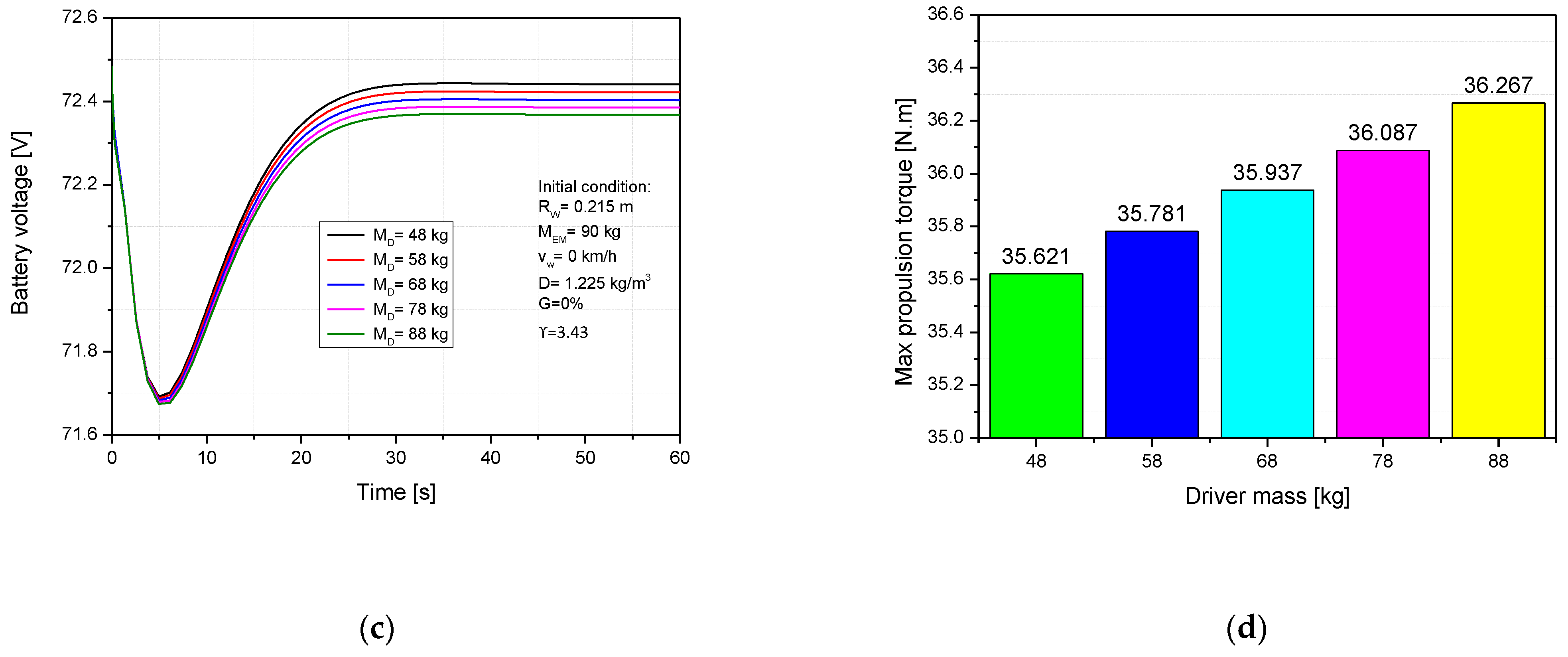
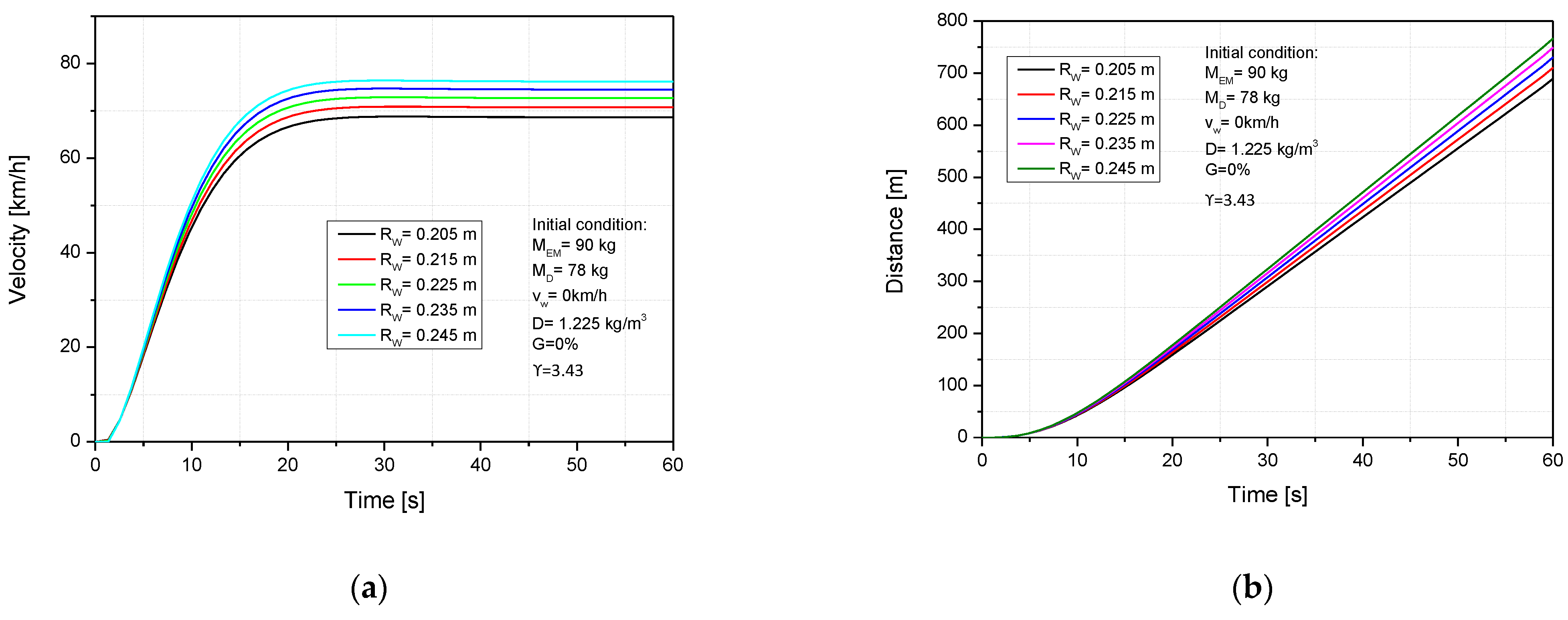




| Speed Levels | Transmission Ratio Value (ϒ) |
|---|---|
| Speed_1 | 2.66 |
| Speed_2 | 3 |
| Speed_3 | 3.43 |
| Speed_4 | 4.12 |
| Speed_5 | 4.94 |
Publisher’s Note: MDPI stays neutral with regard to jurisdictional claims in published maps and institutional affiliations. |
© 2021 by the authors. Licensee MDPI, Basel, Switzerland. This article is an open access article distributed under the terms and conditions of the Creative Commons Attribution (CC BY) license (https://creativecommons.org/licenses/by/4.0/).
Share and Cite
Hieu, L.-T.; Khoa, N.X.; Lim, O. An Investigation on the Effects of Input Parameters on the Dynamic and Electric Consumption of Electric Motorcycles. Sustainability 2021, 13, 7285. https://doi.org/10.3390/su13137285
Hieu L-T, Khoa NX, Lim O. An Investigation on the Effects of Input Parameters on the Dynamic and Electric Consumption of Electric Motorcycles. Sustainability. 2021; 13(13):7285. https://doi.org/10.3390/su13137285
Chicago/Turabian StyleHieu, Le-Trong, Nguyen Xuan Khoa, and Ocktaeck Lim. 2021. "An Investigation on the Effects of Input Parameters on the Dynamic and Electric Consumption of Electric Motorcycles" Sustainability 13, no. 13: 7285. https://doi.org/10.3390/su13137285
APA StyleHieu, L.-T., Khoa, N. X., & Lim, O. (2021). An Investigation on the Effects of Input Parameters on the Dynamic and Electric Consumption of Electric Motorcycles. Sustainability, 13(13), 7285. https://doi.org/10.3390/su13137285





